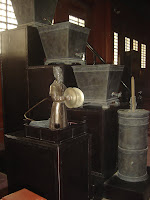

The Old Summer Palace in Beijing features an interesting European style maze.
The maze is still very popular with visitors who find out that things are not as simple as they look. In the middle is an ornate pavilion, or summer house, which is presumably the target destination although anyone reaching it then has to find their way out.
The emperors who lavished money and resources on the Summer Palace, or Yuanming Yuan, were very well aware of the fantastic gardens of Versailles where French kings spared no expense in creating fantasy landscapes. A maze or labyrinth at Versailles was a key feature of the amusements.
Francis Loring Payne wrote a book “The Story of Versailles”, published in 1919. He explained: “An illustrated guide, printed at Amsterdam in 1682, contains the following quaint description of the Labyrinth, or Maze: "Courteous Reader," it begins, "it is sufficiently known how eminently France and especially the Royal Court doth excel above other places with all manner of delights. The admirable faire Buildings and Gardens with all imaginable ornaments and delightful spectacles represent to the eye of the beholder such abundant and rich objects as verily to ravish the spectator.
“Amongst all these works there is nothing more admirable and praiseworthy than the Royal Garden at Versailles, and, in it, the Labyrinth. Other representations are commonly esteemed because they please the eye, but this because it not only delights the ear and eye, but also instructs and edifies. This Labyrinth is situated in a wood so pleasant that Daedalus himself would have stood amazed to behold it. The Turnings and Windings, edged on both sides with green cropt hedges, are not at all tedious, by reason that at every hand there are figures and water-works representing the mysterious and instructive fables of Aesop, with an explanation of what Fable each Fountain representeth carved on each in black marble.
“Among all the Groves in the Park at Versailles the Labyrinth is the most to be recommended, as well for the novelty of the design as the number and diversity of the fountains that with ingenuity and naïveté express the philosophies, of the sage Aesop. The animals of colored bronze are so modeled that they seem truly to be in action. And the streams of water that come from their mouths may be imagined as bearing the words of the fable they represent. There are a great number of fountains, forty in all, each different in subject, and of a style of decoration that blends with the surrounding verdure. At the entrance to the Maze is a bronze statue of Aesop himself--the famous Mythologist of Phrygia."
The Chinese emperors were well aware of the glories of Versailles, largely due to the presence in Beijing of French Jesuit priests. The Qianlong emperor, who ruled from 1735 to 1796 and who grew up at the Summer Palace, was very interested in the French palaces and gardens. Between 1745 and 1796 a large number of foreign-style palaces, fountains, gardens and other delights were built at the Summer Palace. Presumably the stone-walled maze dates from this period. Although it has Chinese elements the maze is in a decidedly foreign style with a particularly distinctive pavilion in the middle.
In the early 1780s, Qianlong decided to have a series of line-engravings made of his European palaces and the series was prepared by local artisans following European styles. Several copies of these engravings are now in the collection of the Biliotheque Nationale de France in Paris, including an etching of the maze which measures 49.4 by 86.7cm. The etching is reproduced in the lavish book “From Beijing to Versailles, Artistic Relations Between China and France, published to accompany a major exhibition in Hong Kong in 1997. ISBN 962 215 151 5. UC 10646. Published by the Urban Council of Hong Kong and produced by the Hong Kong Museum of Art.
The caption to the maze engraving, by Jean-Paul Desroches, explains that the picture “…offers a sort of bird´s eye view to the north with vanishing lines which disappear into the wooded hill in the background. The maze emerges from a lush, green copse, it is surrounded by a river and bordered on three sides by rockwork. The south section is square with a series of walls which fit successively into each other, culminating at the four corners in four honeycombed spaces each planted with a tree pruned into a parasol shape. In the centre stands a high summer-house, octagonal in section and with a basilica roof. To the north, in the alignment of the summer-house, can be seen a rectangular pavilion with similar ornamental features.”
Anyone wishing to visit the maze and the ruins of the palaces, destroyed by the French and British in 1860, should be careful to head for the Old Summer Palace, or Yuanming Yuan, and not the new Summer Palace which is close by. The English signs at Yuanming Yuan are of no help. The palaces are in the Xianglou Area and the best way to get there is by walking due north from the main entrance to the Feng He Lou area where electric vehicles run to Xianglou.
***
©Phillip Bruce 2009.

















